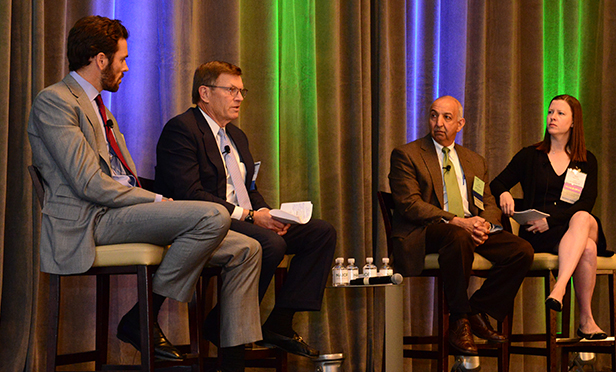 Left to right: Nicholas Pell, Rusty Tamlyn, John Thomas, Mary Lang
Left to right: Nicholas Pell, Rusty Tamlyn, John Thomas, Mary Lang
JERSEY CITY, NJ—Interest rates are likely to rise at some point and equity returns will compress to offset the change, but the pending US presidential election is unlikely to significantly alter investment trends in the industrial space, say members of the “Capital Investment Climate” panel that closed out NAIOP’s I.CON: Trends and Forecasts conference in Jersey City, NJ.
Panelists said the presidential election was in “uncharted territory,” because of the high unfavorability ratings of both candidates. “It’s like reality television,” said panel moderator Mary Lang from Prologis, Inc. A show of hands from the audience indicated participants expect Hillary Clinton to win the election. “Interesting for a real estate crowd,” said Lang. “I guess you didn’t attend the Trump School of Real Estate, no one here?” she joked.
“Capital still has to be deployed,” said panelist Rusty Tamlyn, SIOR, senior managing director, HFF. “I think it was Warren Buffet who said, ‘You’ve got 435 people in Congress, 100 senators and one president. 536 people are not going to be able to derail the greatest economy in the world.’ A lot of it’s noise, but we’ve never been where we are before.”
“Americans are very proprietary,” said panelist John Thomas of CBRE, noting that the US political turmoil is not unique. Political unrest is rising in Europe as well, as the UK debates an exit from the European Union, and France, Poland, and other countries go through political transitions as well. “The capital decision-makers are still having to look at all these factors.”
Industrial transaction volume slowed in the first quarter of 2016, partly because the first quarter activity in 2015 included several groups “taking out non-core large portfolios that did not transact, partly because they were multiple product types in multiple cities,” said Tamlyn. “Size is not necessarily your friend today.”
There are many more players able to do transactions in the $20 million to $100 million range than there are in the $1 billion range, Tamlyn said.
Noting that Gramercy Property Trust “has been noticeably absent from the feeding frenzy with respect to true core product,” Lang asked panelist Nicholas Pell, managing director, head of investments, Gramercy Property Trust, about imbalances in the market he thought were ripe “for exploitation.”
The public REIT has more than $80 million in net investment in primary and secondary market warehouse properties nationally, but Pell said Gramercy is also buying “fringe products which fall off the screen for typical core investors” because of size, debt, and functionality.
“We can get paid, in some markets, 150 to 200 basis points of spread on those deals, and if you have enough lease duration, which is part of our strategy, you can get what we think are superior returns,” he says. “It’s more of a reaction to the rest of the market and the pricing that we’re seeing on a lot of these assets that are trading above replacement cost.”
“Unleveraged returns matter, and most of the underwriting we’re doing is focused on unleveraged,” he said. “Everything we’re underwriting, we’re expanding our cap rates.”
Although interest rates in the US remain high relative to other parts of the world, it is still far easier to move capital from Singapore to the US than to move actual product, Thomas said.
“Cap rates are still compressing on the west coast, some deals are getting ready to trade under four,” said Tamlyn. “In the middle part of the country, Dallas, Houston, Atlanta, some deals trading under a five cap, but if you look at the historical spread between cap rates and interest rates, to average five cap on a new built A product or 6.5 to seven on an older B, that’s still within the historical range.”
He noted that ten countries actually have negative interest rates right now, saying, “Everyone’s starving for yield right now.”
Risk free interest rates in the US have hovered around two percent for about eight years, says Pell, putting pressure on equity returns. “The cumulative effect of that is equity returns have compressed a lot, and I think have room to compress from here. When that translates into higher cap rates, no one knows,” he says.

















 Copyright © 2024 ALM Global, LLC. All Rights Reserved.
Copyright © 2024 ALM Global, LLC. All Rights Reserved.